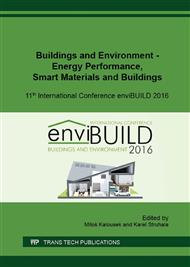[1]
S. C. Carpenter, and A. McGowan. Three-dimensional heat transfer effects in building components. Symposium, ASHRAE Transactions 104 (1998) pp.1070-1076.
Google Scholar
[2]
ISO 15099 Thermal performance of windows, doors and shading devices - Detailed calculations, International Organization for Standardization, Geneva, (2003).
Google Scholar
[3]
U. Larson, B. Moshfegh, and M. Sandberg. Thermal analysis of super insulated windows (numerical and experimental investigations). Energ. Buildings 29 (1999) pp.121-129.
DOI: 10.1016/s0378-7788(98)00041-3
Google Scholar
[4]
Y. Fang, P.C. Eames, The effect of glass coating emittance and frame rebate on heat transfer through vacuum and electrochromic vacuum glazed windows. Sol. Energ. Mat. Sol. Cells 90 (2006) p.2683–2695.
DOI: 10.1016/j.solmat.2006.04.006
Google Scholar
[5]
STN 730540-2/Z1. Thermal protection of buildings. Thermal performance of buildings and components. Functional requirements, Slovak Office of Standards, Metrology and testing, (2016).
Google Scholar
[6]
A. Sedláková, L. Ťažký, S. Vilčeková, E. K. Burdova, Use of traditional and non-traditional materials for thermal insulation of walls, In: Advances and Trends in Engineering Sciences and Technologies Taylor & Francis, London, 2016, pp.387-392.
DOI: 10.4028/www.scientific.net/kem.635.165
Google Scholar
[7]
INTERM SPORO SUPER - insulating glass, test report No. A – 52C/(2007).
Google Scholar
[8]
T. Tomášik, Possibilities of innovation introduction in the selected company, Diploma thesis, The Technical University of Košice, Košice, (2016).
Google Scholar
[9]
V. Sousa, T. D. Pereira, I. Meireles, Modeling the Degradation Rate of the Wood Frame Doors and Windows of the National Palace of Sintra, Portugal. J. Perform. Constr. Fac. 30 (2016) pp.1-10.
DOI: 10.1061/(asce)cf.1943-5509.0000747
Google Scholar
[10]
G. Baldinelli, F. Bianchi, Windows Thermal Resistance: Infrared Thermography aided Comparative Analysis among Finite Volumes Simulations and Experimental Methods, Appl. Energ., 136 (2014), p.250–258.
DOI: 10.1016/j.apenergy.2014.09.021
Google Scholar
[11]
M. Flimel, Differences Ug - values of glazing measured in situ with the influence factors of the internal environment. Adv. Mat. Res. 649 (2013), pp.61-64.
DOI: 10.4028/www.scientific.net/amr.649.61
Google Scholar


